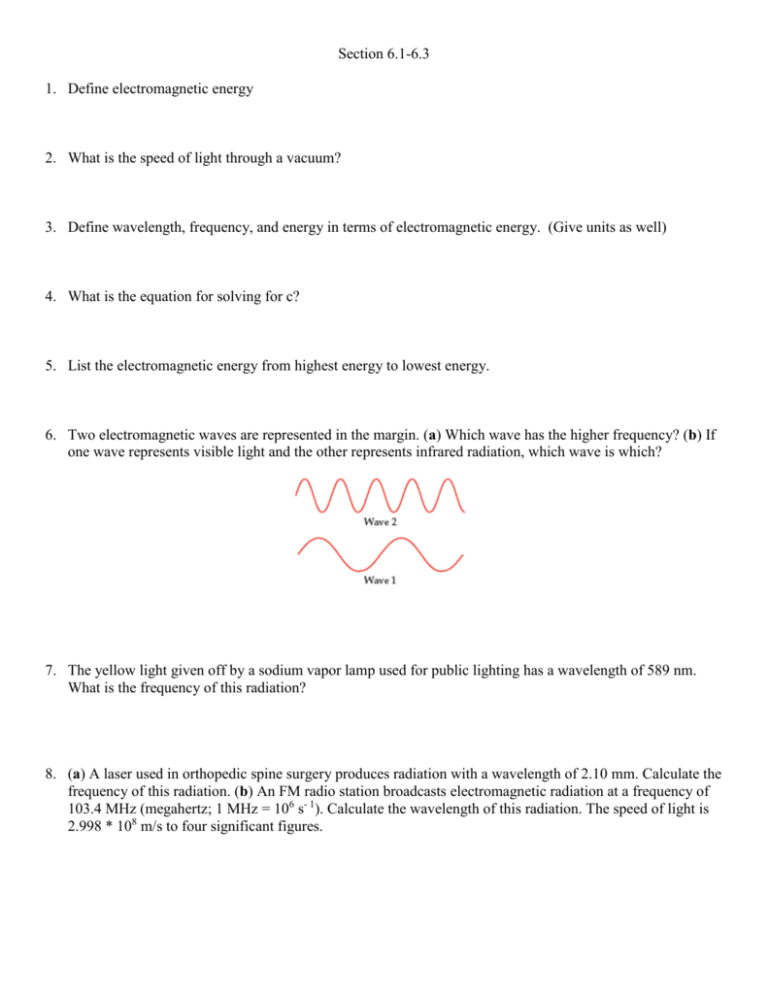Section 6.1-6.3 Define electromagnetic energy What is the speed of
advertisement

Section 6.1-6.3 1. Define electromagnetic energy 2. What is the speed of light through a vacuum? 3. Define wavelength, frequency, and energy in terms of electromagnetic energy. (Give units as well) 4. What is the equation for solving for c? 5. List the electromagnetic energy from highest energy to lowest energy. 6. Two electromagnetic waves are represented in the margin. (a) Which wave has the higher frequency? (b) If one wave represents visible light and the other represents infrared radiation, which wave is which? 7. The yellow light given off by a sodium vapor lamp used for public lighting has a wavelength of 589 nm. What is the frequency of this radiation? 8. (a) A laser used in orthopedic spine surgery produces radiation with a wavelength of 2.10 mm. Calculate the frequency of this radiation. (b) An FM radio station broadcasts electromagnetic radiation at a frequency of 103.4 MHz (megahertz; 1 MHz = 106 s- 1). Calculate the wavelength of this radiation. The speed of light is 2.998 * 108 m/s to four significant figures. 9. What are the three exceptions to the behavior of light listed in section 6.2? 10. What is a quantum and planck’s constant? 11. What is the photoelectric effect? 12. What is a photon? How do you calculate the energy of a photon? 13. What is the work function? 14. Calculate the energy of one photon of yellow light that has a wavelength of 589 nm? 15. (a) A laser emits light that has a frequency of 4.69 * 1014 s- 1. What is the energy of one photon of this radiation? (b) If the laser emits a pulse containing 5.0 * 1017 photons of this radiation, what is the total energy of that pulse? (c) If the laser emits 1.3 * 10- 2 J of energy during a pulse, how many photons are emitted? 16. What is a light spectrum? What is a continuous spectrum? Line spectrum? 17. What is the Rydberg equation? 18. What were Bohr’s three postulates? 19. What is the energy equation for a hydrogen like electron? 20. What is the principle quantum number? 21. What is the ground state and the excited state? 22. What are the transition states for the Lyman, Balmer, Paschen series? 23. What does it mean when the energy level become infinity? 24. Using Figure 6.12, predict which of these electronic transitions produces the spectral line having the longest wavelength: n = 2 to n = 1, n = 3 to n = 2, or n = 4 to n = 3. 25. What are the limitations to the Bohr Model? 26. Consider the water wave shown here. (a) How could you measure the speed of this wave? (b) How would you determine the wavelength of the wave? (c) Given the speed and wavelength of the wave, how could you determine the frequency of the wave? (d) Suggest an independent experiment to determine the frequency of the wave. 27. A popular kitchen appliance produces electromagnetic radiation with a frequency of 2450 MHz. With reference to Figure 6.4, answer the following: (a) Estimate the wavelength of this radiation. (b) Would the radiation produced by the appliance be visible to the human eye? (c) If the radiation is not visible, do photons of this radiation have more or less energy than photons of visible light? (d) Which of the following is the appliance likely to be? (i) A toaster oven, (ii) A microwave oven, or (iii) An electric hotplate. 28. Stars do not all have the same temperature. The color of light emitted by stars is characteristic of the light emitted by hot objects. Telescopic photos of three stars are shown below: (i) the Sun, which is classified as a yellow star, (ii) Rigel, in the constellation Orion, which is classified as a blue-white star, and (iii) Betelgeuse, also in Orion, which is classified as a red star. (a) Place these three stars in order of increasing temperature. (b) Which of the following principles is relevant to your choice of answer for part (a): The uncertainty principle, the photoelectric effect, blackbody radiation, or line spectra? 29. The familiar phenomenon of a rainbow results from the diffraction of sunlight through raindrops. (a) Does the wavelength of light increase or decrease as we proceed outward from the innermost band of the rainbow? (b) Does the frequency of light increase or decrease as we proceed outward? (c) Suppose that instead of sunlight, the visible light from a hydrogen discharge tube (Figure 6.10) was used as the light source. What do you think the resulting “hydrogen discharge rainbow” would look like? 30. What are the basic SI units for (a) the wavelength of light, (b) the frequency of light, (c) the speed of light? 31. Label each of the following statements as true or false. For those that are false, correct the statement. (a) Visible light is a form of electromagnetic radiation. (b) Ultraviolet light has longer wavelengths than visible light. (c) X rays travel faster than microwaves. (d) Electromagnetic radiation and sound waves travel at the same speed. 32. Arrange the following kinds of electromagnetic radiation in order of increasing wavelength: infrared, green light, red light, radio waves, X rays, ultraviolet light. 33. (a) What is the frequency of radiation that has a wavelength of 10 mm, about the size of a bacterium? (b) What is the wavelength of radiation that has a frequency of 5.50 * 1014 s- 1? (c) Would the radiations in part (a) or part (b) be visible to the human eye? (d) What distance does electromagnetic radiation travel in 50.0 ms? 34. A laser pointer used in a lecture hall emits light at 650 nm. What is the frequency of this radiation? Using Figure 6.4, predict the color associated with this wavelength. 35. If human height were quantized in 1-foot increments, what would happen to the height of a child as she grows up: (i) The child’s height would never change, (ii) the child’s height would continuously get greater, (iii) the child’s height would increase in “jumps” of 1 foot at a time, or (iv) the child’s height would increase in jumps of 6 in? 36. (a) Calculate the energy of a photon of electromagnetic radiation whose frequency is 2.94 * 1014 s- 1. (b) Calculate the energy of a photon of radiation whose wavelength is 413 nm. (c) What wavelength of radiation has photons of energy 6.06 * 10- 19 J? 37. (a) Calculate and compare the energy of a photon of wavelength mm with that of wavelength 0.154 nm. (b) Use Figure 6.4 to identify the region of the electromagnetic spectrum to which each belongs. 38. One type of sunburn occurs on exposure to UV light of wavelength in the vicinity of 325 nm. (a) What is the energy of a photon of this wavelength? (b) What is the energy of a mole of these photons? (c) How many photons are in a 1.00 mJ burst of this radiation? (d) These UV photons can break chemical bonds in your skin to cause sunburn—a form of radiation damage. If the 325-nm radiation provides exactly the energy to break an average chemical bond in the skin, estimate the average energy of these bonds in kJ/mol. 39. A diode laser emits at a wavelength of 987 nm. (a) In what portion of the electromagnetic spectrum is this radiation found? (b) All of its output energy is absorbed in a detector that measures a total energy of 0.52 J over a period of 32 s. How many photons per second are being emitted by the laser? 40. Molybdenum metal must absorb radiation with a minimum frequency of 1.09 * 1015 s- 1 before it can eject an electron from its surface via the photoelectric effect. (a) What is the minimum energy needed to eject an electron? (b) What wavelength of radiation will provide a photon of this energy? (c) If molybdenum is irradiated with light of wavelength of 120 nm, what is the maximum possible kinetic energy of the emitted electrons? 41. Explain how the existence of line spectra is consistent with Bohr’s theory of quantized energies for the electron in the Hydrogen atom. 42. (a) Consider the following three statements: (i) A hydrogen atom in the n = 3 state can emit light at only two specific wavelengths, (ii) a hydrogen atom in the n = 2 state is at a lower energy than the n = 1 state, and (iii) the energy of an emitted photon equals the energy difference of the two states involved in the emission. Which of these statements is or are true? (b) Does a hydrogen atom “expand” or “contract” as it moves from its ground state to an excited state? 43. Is energy emitted or absorbed when the following electronic transitions occur in hydrogen? (a) from n = 4 to n = 2, (b) from an orbit of radius 2.12 Å to one of radius 8.46 Å, (c) an electron adds to the H+ ion and ends up in the n = 3 shell? 44. (a) Using Equation 6.5, calculate the energy of an electron in the hydrogen atom when n = 2 and when n = 6. Calculate the wavelength of the radiation released when an electron moves from n = 6 to n = 2. (b) Is this line in the visible region of the electromagnetic spectrum? If so, what color is it? 45. The visible emission lines observed by Balmer all involved nf = 2. (a) Which of the following is the best explanation of why the lines with nf = 3 are not observed in the visible portion of the spectrum: (i) Transitions to nf = 3 are not allowed to happen, (ii) transitions to nf = 3 emit photons in the infrared portion of the spectrum, (iii) transitions to nf = 3 emit photons in the ultraviolet portion of the spectrum, or (iv) transitions to nf = 3 emit photons that are at exactly the same wavelengths as those to nf = 2. (b) Calculate the wavelengths of the first three lines in the Balmer series—those for which ni = 3, 4, and 5—and identify these lines in the emission spectrum shown in Figure 6.11. 46. One of the emission lines of the hydrogen atom has a wavelength of 93.07 nm. (a) In what region of the electromagnetic spectrum is this emission found? (b) Determine the initial and final values of n associated with this emission.







